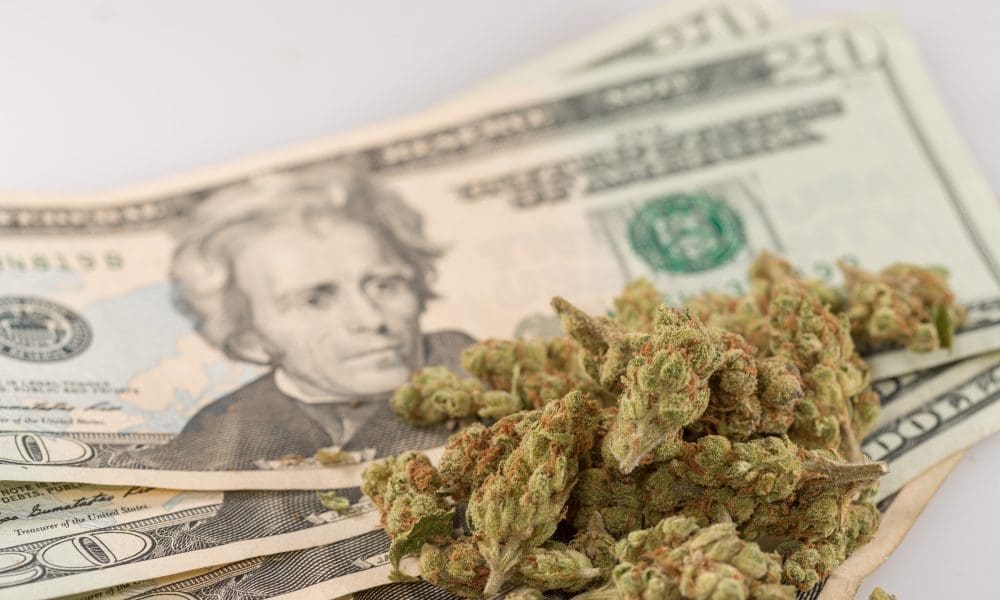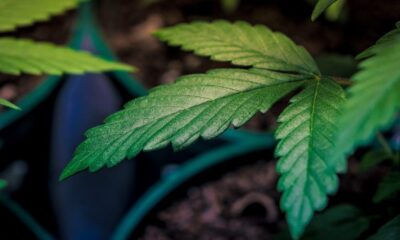featured
California Cannabis Operators Warn That New Tax Hike ‘Could Kill This Industry’
Published
1 day agoon

“We have no objections to how cannabis tax revenues are being spent. All we’re maintaining is that you can’t squeeze blood from a stone.”
By Alexei Koseff, CalMatters
This story was originally published by CalMatters. Sign up for their newsletters.
A substantial tax hike for California’s faltering legal cannabis market took effect on Tuesday, despite an aggressive industry campaign to suspend the increase that won the support of Gov. Gavin Newsom (D) and other political leaders.
The excise tax for weed is 19 percent as of July 1, up from 15 percent—the result of a political deal three years ago that was intended to buy more time for the legal market to stabilize but which cannabis business operators now warn could chase away customers and push them over the edge.
“I’ve never experienced collective malaise like this,” said Genine Coleman, founder of the Origins Council, which represents small farmers in the historic Northern California growing region known as the Emerald Triangle. “People are so concerned with their survival and so deflated. It’s a dangerous space.”
An excise tax is a levy imposed on a good by the state before sales taxes are applied. While a push to freeze the cannabis excise tax through the state budget failed last month, a bill that would lower the rate back to 15 percent for the next six years is still moving through the Legislature. Newsom has pledged to sign a proposal halting the tax increase if it reaches his desk.
“I’m intimately familiar with the conversations around that and have great confidence that we’ll achieve our stated goals,” Newsom said during a press conference Monday.
Cannabis growers, dispensary owners and consumer advocates rallied for months at the state Capitol to avert the tax increase, which they argue could deal a fatal blow to businesses already operating with slim margins.
The price of weed has plummeted since voters legalized recreational cannabis through Proposition 64 in 2016, the result of a rush to overproduction even as most cities and counties in the state remain closed off to retail sales. Meanwhile, California is struggling to bring its market out of the shadows; the state Department of Cannabis Control estimates that legal sales still comprise less than 40 percent of weed consumption in California, which the industry attributes to state and local excise and sales taxes that can increase prices for consumers by a third.
Taxable cannabis sales in California dropped to $1.09 billion for the first quarter of 2025, down 30 percent from their peak in early 2021 and the lowest quarterly sales in five years.
Tax was intended to offset cannabis harms
It’s a crisis for the industry—communities that traditionally relied on cannabis production have collapsed economically—but also a problem for the state’s finances. Tax revenues from weed sales provide guaranteed funding for child care slots, environmental cleanup, substance abuse education and impaired driving prevention efforts as California faces a growing budget deficit.
“This was a poor time to say, ‘let’s starve the state even more,’” said Tom Wheeler, the executive director of the Humboldt County-based Environmental Protection Information Center, which joined a coalition of child care, environmental and tribal advocacy groups to lobby against a tax freeze.
He said it was important to uphold the promise of Proposition 64, which includes using cannabis tax revenue for programs that offset the harms caused by the cannabis industry, and expressed skepticism that the tax increase would hurt sales.
“I think the average consumer would not notice that,” Wheeler said. “At what point do we stop cutting taxes to benefit the industry?”
The 2022 agreement offered relief to growers by eliminating a cultivation tax, but it allowed state regulators, after a three-year pause, to raise the excise tax to make up for the lost revenue.
During budget negotiations last month, Newsom—who also wants to begin using cannabis tax revenue for enforcement against illegal cultivation—and Assembly Speaker Robert Rivas, a Democrat from Salinas, supported extending the pause on the excise tax. They could not reach a compromise with Senate President Pro Tem Mike McGuire, a Healdsburg Democrat who notably represents the Emerald Triangle.
In a statement, McGuire said “taxes on California’s overregulated cannabis industry have been a train wreck for years,” but he raised concerns about the fiscal implications of freezing the tax. State analysts estimate that increasing it to 19 percent could yield about $180 million per year for the state.
“It’s important to acknowledge that any freeze will create a budget shortfall which would impact critical community programs funded by cannabis tax dollars,” he said.
California could ‘forfeit a huge opportunity’
Industry representatives warn that further raising taxes will push price-sensitive customers back into the illicit market, hurting businesses teetering on the edge and actually lowering cannabis tax revenue in the long run.
“The math isn’t there,” said Amy O’Gorman Jenkins, executive director and lobbyist for the California Cannabis Operators Association. “We have no objections to how cannabis tax revenues are being spent. All we’re maintaining is that you can’t squeeze blood from a stone.”
They haven’t given up, though repealing the tax increase now that it’s taken effect will be even more challenging.
Assembly Bill 564, which would set the cannabis excise tax at 15 percent through the end of June 2031, passed the Assembly unanimously in May and now awaits consideration in the Senate.
Assemblymember Matt Haney, the San Francisco Democrat who introduced the measure, said he will keep fighting to get it to the governor. But he was furious that the Senate allowed the tax hike to take effect, which he said sent a message to legal cannabis operators that there is no incentive to follow the rules.
“This tax could kill this industry and there’s still not enough being done,” he said. “California is going to forfeit what should have been a huge opportunity for our state.”
This article was originally published on CalMatters and was republished under the Creative Commons Attribution-NonCommercial-NoDerivatives license.

Author: mscannabiz.com
MScannaBIZ for all you Mississippi Cannabis News and Information.
You may like
-


Marijuana Users In Iowa Are Engaged And Active Citizens, Survey Shows—Smashing ‘Lazy Stoner’ Stereotypes
-


Here’s Where To Buy Legal Recreational Marijuana In Delaware Next Month
-


Fireworks, marijuana and cash found in Bronx apartment – NBC New York
-


How often are marijuana cases federally prosecuted?
-


A Brief History of Getting High
-


Rhode Island Marijuana Regulators Seeking Applications For New Dispensary In State’s Northern Region
featured
Marijuana Users In Iowa Are Engaged And Active Citizens, Survey Shows—Smashing ‘Lazy Stoner’ Stereotypes
Published
1 hour agoon
July 6, 2025
“Many of today’s cannabis consumers are ‘middle American’ adults, employed, own a home, vote regularly, pay their taxes and are involved in their communities.”
By Bob Sillick, Iowa Capital Dispatch
For many years, cannabis users were characterized as a cult of stoners: young, often unemployed, party animals. That sector still exists in some form, however, many of today’s cannabis consumers are “middle American” adults, employed, own a home, vote regularly, pay their taxes and are involved in their communities.
That is the general profile of adult cannabis consumers across the country and in Des Moines, according to a recent survey by Consumer Research Around Cannabis/The Media Audit.
The Media Audit, the parent company of Consumer Research Around Cannabis, is an international research company serving 80+ local markets in the U.S. and Canada for more than 20 years. It started gathering data about cannabis use and attitudes in 2016.
Although the sale of adult recreational cannabis is illegal in Iowa, the survey found 16.2 percent of all adults age 18+ in Des Moines said they used or bought cannabis during the past month, or the statistical equivalent of approximately 140,000 adults.
The smallest percentage in the following table, monthly usage in Des Moines, is still substantial—and suggests a pent-up market. Unleashing the recreational cannabis market in Des Moines and all of Iowa would likely generate jobs and significant taxes for the state—money now escaping across the borders.

The survey data from Des Moines and 42 other markets was aggregated and showed 24.1 percent of adults 18+ used or bought cannabis during the past month. (Local factors affect these percentages and comparisons.)
For 15 years, Jonathan Caulkins, H. Guyford Stever professor of operations research and public policy at Carnegie Mellon University’s Heinz College, has been studying cannabis legalization. He is also the author of several books on the topic and a member of the Commission on the North American Opioid Crisis.
Caulkins’s research fine-tunes the results of the Des Moines survey from Consumer Research Around Cannabis.
“From 1992 through 2023, the most recent year for which we have released data, the trend has been towards an enormous increase in the number of people who are using cannabis daily or near daily. They account for 80 percent of recreational cannabis sales. They dominate the market,” Caulkins said.
In states like Iowa that haven’t legalized adult recreational cannabis, Caulkins expects when they do, the middle of the market will be blue-collar high-school graduates, adults 25–40 who are employed but not affluent.
He has also seen a gender trend as more states allow the sale of recreational cannabis.
“As cannabis has become more legal, the male/female use gap has become noticeably smaller. When it was an illegal action or a risky action, there was a much bigger gender gap, but that gap is declining. Use by men is increasing with legalization, use by women is increasing even more,” he said.
Cannabis consumers in Des Moines also align with the 43-market survey when comparing gender and income. Millennials at 42.3 percent and Gen Xers at 35.5 percent account for three-quarters of the adult cannabis consumers in Des Moines who bought or used cannabis during the past month. These percentages are slightly more than the 43-market survey at 41.5 percent and 28.2 percent, respectively. The 33.8 percent of cannabis consumers in Des Moines with household incomes of $35,000 to $75,000 is also slightly more than the 43-market survey at 29.6 percent.
The Consumer Research Around Cannabis data also profiles cannabis consumers at a more granular level. The “household profile” category shows which three were the largest purchasers or users of cannabis during the past year, or 33.8 percent collectively.
- Affluent, no children at home: $75,000+ household income
- Affluent white-collar worker: Family income $100,000+
- Affluent Boomers: $100,000+ household income
Comparing cannabis purchasers and users in Des Moines with the 43-market survey by their employment status and occupation reveals some contrasts. The data indicates that many in Des Moines are working and contributing to the local economy.

Voting is a meaningful measure of civic responsibility. Millennials at 22 percent, Gen Xers at 54.4 percent and Baby Boomers at 12 percent who purchased or used cannabis during the past month voted in local, state and national elections, compared to 33 percent, 32.1 percent and 24.6 percent, respectively, in the 43-market aggregate survey.
This particular data point may have ramifications for future legislative efforts to legalize adult recreational cannabis sales in Iowa. While the Iowa Legislature’s majority Republicans have rebuffed Democrats’ proposals to legalize recreational marijuana, advocates suggest time may be on their side if an increasing body of citizens support legalization with their votes.
Marijuana’s Schedule I Status ‘Traps Researchers In A Paradox,’ Federally Funded Scientists Say

Author: mscannabiz.com
MScannaBIZ for all you Mississippi Cannabis News and Information.
featured
Here’s Where To Buy Legal Recreational Marijuana In Delaware Next Month
Published
2 hours agoon
July 6, 2025
All seven medical marijuana operators have converted to adult-use cannabis sales, with over 10 locations, which will be up and running in August.
By Brianna Hill, Spotlight Delaware
Delaware will begin recreational marijuana sales on August 1, state officials announced Tuesday, putting the first definitive date on the start of a long-awaited rollout for the $280 million industry.
Customers on that first day will be heading to existing medical marijuana businesses though, as the burgeoning legal market has yet to develop the dozens of new businesses licensed for recreational-only sales.
That decision has already sparked criticism from advocates and residents, who say it puts other businesses at an unfair disadvantage.
For years, medical marijuana dispensaries have denied that they sought the handful of licenses available at the time in order to get a first-adopter advantage for the eventual recreational market. But now that is occurring.
“The existing medical marijuana dispensaries lobbied for less competition and to begin sales before new businesses, and now, with the [Office of the Marijuana Commissioner]-caused delays, they will end up with first sales and absolutely no competition,” Zoë Patchell, president of the Delaware Cannabis Advocacy Network, which advocated for years for legalization, wrote in a Facebook post.
Delaware medical marijuana dispensaries

Jacob Owens, Spotlight Delaware / Source: Delaware Office of the Marijuana Commissioner / Created with Datawrapper
- First State Compassion–Wilmington, 37 Germay Drive, Wilmington http://firststatecompassion.com
- First State Compassion–Lewes, 12000 Old Vine Blvd., Unit 102, Lewes
- http://firststatecompassion.com
- Fresh Cannabis, 635 N. Dupont Blvd., Milford
- https://freshdelaware.com/
- Columbia Care Delaware, 200 S. DuPont Blvd., Smyrna
- https://col-carede.com/
- Columbia Care Delaware, 5606 Concord Pike, Wilmington
- https://col-carede.com/
- Columbia Care Delaware, 36725 Bayside Outlet Drive, Suite 760, Rehoboth Beach
- https://col-carede.com/
- Field Supply, 4543 Kirkwood Highway, Wilmington
- https://thefieldsupply.com
- Fresh Cannabis, 800 Ogletown Road, Newark
- https://freshdelaware.com/
- Fresh Cannabis, 22983 Sussex Highway, Seaford
- https://freshdelaware.com/
- The Farm, 105 Irish Hill Road, Felton
- https://www.thefarmde.com
- The Farm, 240 S. Dupont Highway, New Castle
- https://www.thefarmde.com
- Best Buds, 516 Jefferic Blvd., Dover
- https://www.bestbuds.com
- Best Buds, 23 Georgetown Plaza, Georgetown
- https://bestbuds.com
Delaware’s adult-use marijuana industry, which was legalized in 2023, allowed for 125 licensees to operate throughout the state across cultivation, manufacturing, testing and retail sales. The operators were chosen at the end of last year through a lottery system that saw more than 1,200 individuals apply.
Entering the licensing lottery alone required individuals to submit detailed applications and fees. Most application fees cost $5,000, with the active license itself costing up to $10,000.
Medical marijuana operators seeking to enter the recreational market were required to pay steep conversion fees—$100,000 for retail or manufacturing licenses and $200,000 for cultivation.
The state used the revenue to create a $4 million reimbursement fund for social equity applicants, defined as individuals with prior marijuana-related convictions or those from communities disproportionately impacted by prior marijuana enforcement.
Since March, business operators have been awaiting clarity from the Office of the Marijuana Commissioner (OMC), the state office in charge of regulating the industry, on when sales could legally begin.
The market’s launch was originally slated for April but faced delays after the state failed to secure FBI approval to conduct background checks on licensees.
As of June 18, 43 individuals have cleared their background checks, according to OMC spokeswoman Keila Montalvo. The office did not respond to requests for information on how many conditional licenses have been issued.
Even as an official date is set, state lawmakers are still trying to revise the law that made recreational sales legal.
The law permitted municipalities to prohibit marijuana businesses from their jurisdictions and gave counties broad authority to dictate where they could locate, but those allowances have led a third of Delaware towns and cities to opt out of allowing marijuana shops and Sussex County to place significant restrictions on locations.
A bill to lessen those restrictions has passed both the House and Senate and now awaits consideration from Gov. Matt Meyer (D).
All seven medical marijuana operators have converted to adult-use cannabis sales, with over 10 locations, which will be up and running in August.
Given the ongoing barriers faced by other licensees, including strict local zoning rules, delayed funding for social equity applicants and pending conditional license approvals, the early start for medical marijuana businesses could give them a major head start in shaping the market.
“Our focus is on building a safe, equitable, and accountable marijuana market that delivers real benefits to Delawareans. We will continue to issue conditional licenses to previously selected applicants to ensure they can begin operations once active,” Joshua Sanderlin, Delaware’s new marijuana commissioner, said in a statement.
This story was first published by Spotlight Delaware.
8 In 10 Marijuana Consumers Use It As A Substitute For Prescription Drugs, New Survey Finds

Author: mscannabiz.com
MScannaBIZ for all you Mississippi Cannabis News and Information.
Nowadays, people tend to associate the cannabis plant with Mexico, and for good reason. For decades, narcos smuggled their harvests into the United States and Europe. Along with California, Mexico is known to produce some of the finest cannabis in the world. The states of Sinaloa, Nayarit, Jalisco, Michoacán, Guerrero, Oaxaca, Chihuahua, Sonora, and Durango—where the largest farms are located—all have climates that are perfect for cultivating cannabis: year-round temperature ranging between 70 and 85 degrees Fahrenheit, with cool, long nights and low humidity.
But long before cannabis was introduced to—and became synonymous with—the New World, it was being cultivated in the lands of Central Asia. Initially, though, the cannabis or hemp plant was grown not for its leaves but for its stems, which could be processed into a strong and durable rope.
Excavations reveal that humans have been using hemp rope since the Neolithic age. The earliest evidence for burning cannabis, meanwhile, dates back to 3,500 BC, and is attributed to the Kurgans of modern-day Romania. This Proto-Indo-European tribe probably burned the plant as part of their rituals and ceremonies, a practice that spread eastward as its practitioners migrated. Why the Kurgans burned cannabis is difficult to say. They may well have discovered the plant’s psychoactive properties by accident, only to find that the smoke heightened their connection with all things spiritual.
The earliest evidence for smoking cannabis comes from the Pamir Mountains in western China. There, in 2500-year-old tombs, researchers discovered THC residue inside the burners of charred pipes that were probably used for funerary rites. (Similar pipes, dated to the 12th century BC, were later found in Ethiopia, left there by a separate culture). These devices, compared to pyres, would have yielded a much stronger high. Given their placement inside a crypt, however, it’s safe to say they were used only ceremonially, not recreationally.
Some scholars have argued that cannabis was an important ingredient of soma, a ritual drink concocted by the Vedic Indo-Aryans of northern India. Described in the Rigveda, a collection of ancient Sanskrit hymns, soma was made by extracting juice from an unknown plant. When taken in small doses, soma was reported to induce a feeling of euphoria. In higher doses, it caused people to see hallucinations and lose their sense of time. All three of these effects have been ascribed to cannabis, but even if cannabis was not the main ingredient of soma, it may have been combined with psychedelics such as psilocybin, a.k.a. magic mushrooms.
Aside from rope, cannabis was most often processed into medicine. When the Hindus of India came down with a case of “hot breath of the gods,” healers treated the illness with cannabis smoke. The logic behind this treatment was not exactly scientific; cannabis was thought to possess healing powers because it was the favorite food of the supreme godhead Shiva, also called “Lord of Bhang.” In reality, cannabis would have been able to reduce fevers because its active ingredient, THC, works on the hypothalamus to lower body temperature.
The Assyrians used cannabis not in a medical but in a religious context, burning it in their temples to release an aroma that supposedly appeased their gods. Sources from the region refer to cannabis as qunubu, providing a possible origin for the word we use today. The Assyrian Empire was conceived in the 21st century BC and lasted until the 7th. During this time, it engulfed much of modern-day Iraq as well as parts of Iran, Kuwait, Syria and Turkey. Through trade and conquest, Assyrian traditions spread to neighboring societies, including the Dacians, Thracians and Scythians, the latter of which were among the first to consume cannabis in a distinctly recreational manner.
The Scythians were part of a Central Asian nomadic culture that flourished from 900 to around 200 BC. Originating in northern Siberia, Scythian tribes settled as far as the shores of the Black Sea, where they came into contact with the ancient Greeks. When Scythians died, their friends and family burned hemp inside tents to commemorate their passing. While the Kurgans and Assyrians burned their cannabis out in the open or in large indoor spaces, the Scythians were essentially hotboxing themselves at every funeral. At least, that’s the image we receive from the historian Herodotus, who wrote that “the Scythians enjoy [the hemp smoke] so much that they would howl with pleasure.” And so, the primary purpose of this ritual was to send off the dead; it clearly also served to entertain the living.
Herodotus did not live among the Scythians, but his observations seem to have been confirmed by excavations. Archeologists discovered fossilized hemp seeds at a Scythian camp in western Mongolia that were left there between the 5th and 2nd century BC.
Romans, too, consumed cannabis for their own pleasure, but not in the way you might expect. Like many societies of classical antiquity, they harvested the plant for its seeds rather than its leaves, which were discarded as a waste product. When grounded, the seeds were used in medicine. When fried, they were served up as delicacies during lavish dinner parties. Roman chefs mentioned cannabis seeds in the same breath as caviar and cakes. Galen, the famous Roman physician, wrote that they were consumed “to stimulate an appetite for drinking.” Nowadays, it’s the seeds—not the leaves—that are considered useless. However, the Romans believed they, too, had some intoxicating properties; Galen adds that, when consumed in large amounts, the seeds would send people into a “warm and toxic vapor.”
Cannabis was so widely consumed in classical antiquity that people raised the same questions and concerns we are debating today. The Greek physician Pedanius Dioscorides, for instance, wrote that the plant’s spherical seeds, “when eaten in excess, diminish sexual potency.” Modern-day cannabis users are all too aware of the connection, even if they don’t eat seeds. As stated by Healthline, cannabis is “often associated with side effects that may affect sexual health, including erectile dysfunction.” Similar to some psychedelics, the general sense of euphoria generated by cannabis may counteract or override the reception of sexual stimuli.
Let’s skip forward a bit. Recreational smoking became especially popular after the 9th century AD. In the Middle East and Western Asia, the followers of Islam took up the habit for the simple but somewhat amusing reason that their holy scripture, the Quran, forbade the consumption of alcohol and various other intoxicating substances. Fortunately for Muslim stoners, the Quran did not say anything about weed. Of course, they smoked not just any weed, but hashish.
Skipping forward again, this time to the 16th century—the century that cannabis arrived in the New World, and for the sole purpose of making rope, no less. Actually, Americans did not start smoking weed until about one hundred years ago, when Mexican immigrants entered the country to seek refuge from the Mexican Revolution. For decades, the U.S. government turned a blind eye on this harmless, multicultural and age-old practice. However, this changed during the Great Depression, when Washington redirected the anger of unemployed workers to their Mexican brethren. After millennia of peaceful consumption, cannabis was suddenly decried as an “evil weed,” and, in 1937, the U.S. became the first country in the world to criminalize cannabis on a national level.
The rest, at this point in time, has now become history as well.
Original publication: 2022

Author: mscannabiz.com
MScannaBIZ for all you Mississippi Cannabis News and Information.

Marijuana Users In Iowa Are Engaged And Active Citizens, Survey Shows—Smashing ‘Lazy Stoner’ Stereotypes

Here’s Where To Buy Legal Recreational Marijuana In Delaware Next Month

Fireworks, marijuana and cash found in Bronx apartment – NBC New York

How often are marijuana cases federally prosecuted?
A Brief History of Getting High

Rhode Island Marijuana Regulators Seeking Applications For New Dispensary In State’s Northern Region

Texas Medical Marijuana Industry Wants Lawmakers To Ban Synthetic Delta-8 THC And Restrict Hemp Products To Adults

California Cannabis Operators Warn That New Tax Hike ‘Could Kill This Industry’
High Times Greats: Jim Morrison

New cannabis tax increase is a high concern for California dispensaries, customers
A Brief History of High Times (2019)

Georgia veterans suffering from PTSD push for medical cannabis expansion on Fourth of July
A Brief Global History of the War on Cannabis
The Evolution of Cannabis in Film
High Times Is Home Again
Dope As Yola Becomes First Weedtuber to Hit 2 Million Subscribers

$20M worth of cocaine, marijuana seized in Caribbean Sea: USCG
Will Success Spoil Cheech & Chong? Of Course (1980)
Prescription-Only Rule Takes Hold Amid Political Ouster

Marijuana Use Is Tied To ‘Significantly Higher Sexual Desire And Arousal,’ New Study Shows
Flashback Friday: Psychedelic Cacti

Trump’s VA Secretary Is ‘Particularly Proud’ Of Psychedelic Research Aimed At Helping Veterans With PTSD

Democratic Senate Sponsor Of Marijuana Banking Bill Says Budget Issues And War Have Delayed Cannabis Reform Efforts

Tifton Police: About 20 pounds of marijuana discovered during traffic stop

Alert: Department of Cannabis Control updates data dashboards with full data for 2023

Connecticut Appoints The US’s First Cannabis Ombudsperson – Yes there is a pun in there and I’m Sure Erin Kirk Is Going To Hear It More Than Once!

5 best CBD creams of 2024 by Leafly

Free delta-9 gummies from Bay Smokes

EU initiative begins bid to open access to psychedelic therapies
New Study Analyzes the Effects of THCV, CBD on Weight Loss

Mississippi city official pleads guilty to selling fake CBD products

May 2024 Leafly HighLight: Pink Runtz strain

Curaleaf Start Process Of Getting Their Claws Into The UK’s National Health System – With Former MP (Resigned Today 30/5/24) As The Front Man

5 best autoflower seed banks of 2024 by Leafly

Horn Lake denies cannabis dispensary request to allow sale of drug paraphernalia and Sunday sales | News

Press Release: CANNRA Calls for Farm Bill to Clarify Existing State Authority to Regulate Hemp Products

Local medical cannabis dispensary reacts to MSDH pulling Rapid Analytics License – WLBT

Discover New York’s dankest cannabis brands [September 2024]

Nevada CCB to Accept Applications for Cannabis Establishments in White Pine County – “Only one cultivation and one production license will be awarded in White Pine County”

6 best CBD gummies of 2024 by Leafly

The Daily Hit: October 2, 2024

5 best THC drinks of 2024 by Leafly

5 best delta-9 THC gummies of 2024 by Leafly

Weekly Update: Monday, May 13, 2024 including, New Guide for Renewals & May Board meeting application deadline

People In This State Googled ‘Medical Marijuana’ The Most, Study Shows

Thailand: Pro-cannabis advocates rally ahead of the government’s plan to recriminalize the plant

PRESS RELEASE : Justice Department Submits Proposed Regulation to Reschedule Marijuana

Press Release: May 9, STIIIZY and Healing Urban Barrios hosted an Expungement Clinic & Second Chance Resource Fair
Trending
-

 California Cannabis Updates1 year ago
California Cannabis Updates1 year agoAlert: Department of Cannabis Control updates data dashboards with full data for 2023
-

 Breaking News1 year ago
Breaking News1 year agoConnecticut Appoints The US’s First Cannabis Ombudsperson – Yes there is a pun in there and I’m Sure Erin Kirk Is Going To Hear It More Than Once!
-

 best list11 months ago
best list11 months ago5 best CBD creams of 2024 by Leafly
-

 Bay Smokes1 year ago
Bay Smokes1 year agoFree delta-9 gummies from Bay Smokes
-

 Business10 months ago
Business10 months agoEU initiative begins bid to open access to psychedelic therapies
-

 cbd1 year ago
cbd1 year agoNew Study Analyzes the Effects of THCV, CBD on Weight Loss
-

 Mississippi Cannabis News1 year ago
Mississippi Cannabis News1 year agoMississippi city official pleads guilty to selling fake CBD products
-

 California1 year ago
California1 year agoMay 2024 Leafly HighLight: Pink Runtz strain

